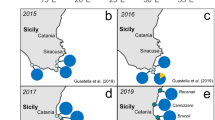The alga has been identified that threatens to smother Californian coastal ecosystems.
Abstract
The recent discovery of the marine green alga Caulerpa taxifolia on the Californian coast1,2 has raised public concern about the potential danger of a new invasion similar to the one endured by the Mediterranean Sea over the past decade. A small colony of C. taxifolia introduced into the Mediterranean in 19843,4 from a public aquarium5 has spread to more than 6,000 hectares today, outcompeting native species and seriously reducing diversity in areas of the northwestern Mediterranean6. This invasive strain of C. taxifolia differs from tropical populations in that it is much larger, grows more vigorously, does not rely on sexual reproduction, and is resistant to low temperatures4,6,7. Here we evaluate the risk of invasion by Californian C. taxifolia by comparing it genetically with the Mediterranean and aquarium strain, as well as with native tropical populations. Our results show that the Californian alga is the same as the invasive Mediterranean strain, calling for its rapid eradication to prevent a new invasion.
This is a preview of subscription content, access via your institution
Access options
Subscribe to this journal
Receive 51 print issues and online access
$199.00 per year
only $3.90 per issue
Buy this article
- Purchase on Springer Link
- Instant access to full article PDF
Prices may be subject to local taxes which are calculated during checkout

Similar content being viewed by others
References
Kaiser, J. Science 289, 222–223 ( 2000).
Dalton, R. Nature 406, 447 (2000).
Meinesz, A. & Boudouresque, C. F. C. R. Acad. Sci. Paris Life Sci. 319, 603–613 ( 1996).
Meinesz, A. & Hesse, B. Oceanol. Acta 14, 415–426 (1991).
Jousson, O., Pawlowski, J., Zaninetti, L., Meinesz, A. & Boudouresque, C. F. Mar. Ecol. Prog. Ser. 172, 275–280 (1998).
Meinesz, A. et al. Bot. Mar. 38, 499– 508 (1995).
Komatsu, T., Meinesz, A. & Buckles, D. Mar. Ecol. Prog. Ser. 146, 145 –153 (1997).
Olsen, J. L., Valero, M., Meusnier, I., Boele-Bos, S. & Stam, W. T. J. Phycol. 34, 850– 856 (1998).
Pighini, M. & Dini, F. 4th International Workshop on Caulerpa taxifolia (Lerici, Italy, 1999).
Author information
Authors and Affiliations
Corresponding author
Rights and permissions
About this article
Cite this article
Jousson, O., Pawlowski, J., Zaninetti, L. et al. Invasive alga reaches California. Nature 408, 157–158 (2000). https://doi.org/10.1038/35041623
Issue Date:
DOI: https://doi.org/10.1038/35041623
This article is cited by
-
The joint influence of environmental and anthropogenic factors on the invasion of two alien caulerpae in northwestern Mediterranean
Biological Invasions (2022)
-
Pros and cons of Ulva lactuca and Cladophora glomerata grown in freshwater as feed
Environmental Science and Pollution Research (2022)
-
Clonal diversity amongst island populations of alien, invasive Lemna minuta kunth
Biological Invasions (2021)
-
Niche conservatism and spread of seaweed invasive lineages with different residence time in the Mediterranean Sea
Biological Invasions (2018)
-
Origins of softshell turtles in Hawaii with implications for conservation
Conservation Genetics (2016)
Comments
By submitting a comment you agree to abide by our Terms and Community Guidelines. If you find something abusive or that does not comply with our terms or guidelines please flag it as inappropriate.



